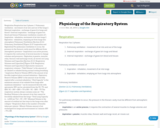
Respiration
Respiration has 3 phases:
1. Pulmonary ventilation - movement of air into and out of the lungs
2. External respiration - exchange of gases b/n lungs and blood
3. Internal respiration - exchange of gases b/n blood and tissues
Pulmonary ventilation consists of
1. Inspiration - inhalation, movement of air into lungs
2. Expiration - exhalation, emptying air from lungs into atmosphere
Pulmonary Ventilation
[Section 22.3.2: Pulmonary Ventilation]
[Figure 22.17: Inspiration and Expiration]
For pulmonary ventilation to occur, the pressure in the thoracic cavity must be different from atmospheric pressure
• Inspiration is an active process, it requires the contraction of several muscles to change volumes and pressures
• Expiration is passive, muscles relax, thoracic wall and lungs recoil, air moves out
Lung Volumes and Capacities
[Section 22.3.3: Respiratory Volumes and Capacities]
[Figure 22.18: Respiratory Volumes and Capacities]
A Spirometer measures respiratory volumes
• Tidal Volume* is the amount of air inhaled or exhaled during normal resting breathing
• Inspiratory Reserve Volume (IRV) is the amount of air forcibly inspired above normal inhalation
• Expiratory Reserve Volume (ERV)* is the amount of air forcibly expired after a normal exhalation
• Vital Capacity* is the maximum amount of air exhaled from lungs after maximum inhalation
* can be measured directly with spirometer
IRV can be calculated from the VC, TV, and ERV:
VC = IRV + ERV + TV à IRV = VC – ERV – TV
The respiratory system always contains some air
• The Residual Volume is the amount of air that cannot be forcefully exhaled from the lungs
• Total Lung Capacity is ~ 6,000 ml; TLC = VC + RV
• Minimal Volume is the amount of residual air that stays in the lungs even after collapse
• Respiratory Rate is the number of breaths taken per minute
• Minute Volume amount of air exchanged b/n lungs and environment in 1 minute: MV = TV x RR
- Subject:
- Applied Science
- Material Type:
- Activity/Lab
- Date Added:
- 11/28/2016